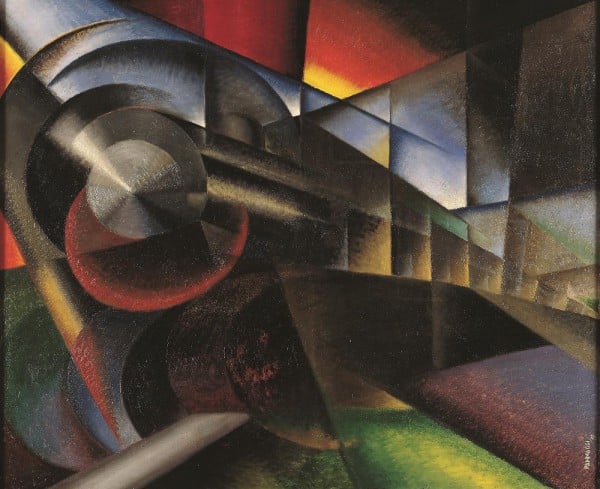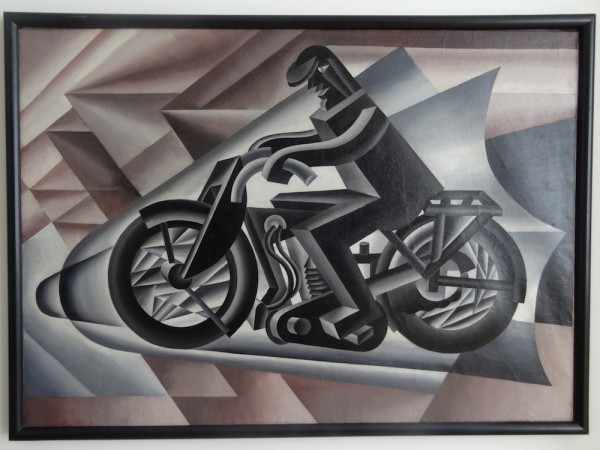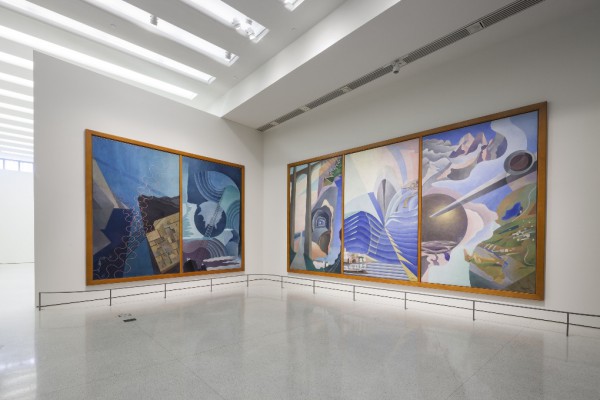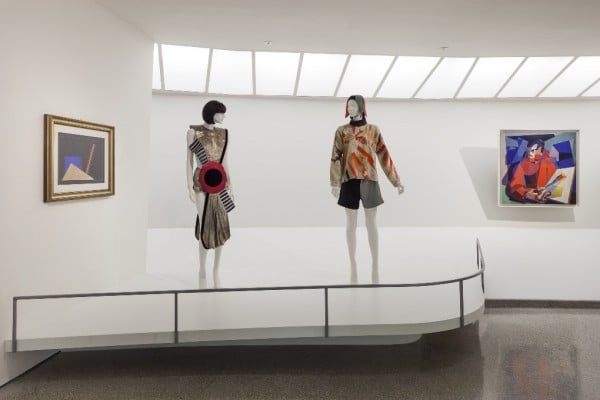Art & Exhibitions
Two Shows in New York Take Us Back to Futurism, Italy’s Messy Modernist Movement
New exhibitions at the Guggenheim and the Center for Italian Modern Art examine Futurism.

New exhibitions at the Guggenheim and the Center for Italian Modern Art examine Futurism.

Benjamin Sutton

The Futurists have been a problematic bunch from the get-go.
On February 20, 1909, Filippo Tommaso Marinetti published “The Founding and Manifesto of Futurism” on the front page of France’s most widely-circulated newspaper, Le Figaro, setting out an ambitious program for a movement whose eventual turn to Fascism seems, in hindsight, rather predictable. “We will glorify war—the world’s only hygiene—militarism, patriotism, the destructive gesture of freedom-bringers, beautiful ideas worth dying for, and scorn for woman,” Marinetti wrote. Five years later, or 100 years ago, many of those ideas espousing speed and mechanized violence and initially explored in poetry, performance, and on canvas became devastatingly real on the battlefields of World War I, a conflict Marinetti is said to have welcomed as a way of doing away with history and tradition.
A century later, the Italian Futurists’ divergent legacies as a radical avant-garde group, a populist alliance of creative polymaths, a technophilic boys’ club, and a far-right, Fascist movement continue to handicap its status as one of the great modern art developments of the first half of the 20th century. Their achievements are often downplayed in art historical accounts, like Hugh Honour and John Fleming’s A World History of Art, which summarily concludes that “in 1916 Futurism came to an end. An attempt to revive it after the war foundered in its alliance with Fascism.”
But it is precisely the movement’s capacity for containing contradiction that makes it so rich and unique, as evidenced by two new exhibitions in New York City: The Guggenheim Museum’s vast historic survey “Italian Futurism, 1909–1944: Reconstructing the Universe,” and a focused presentation devoted to one of the most singular artists therein, Fortunato Depero, at the just-opened Center for Italian Modern Art (CIMA).

Installation view of “Fortunato Depero” at the Center for Italian Modern Art.
Photo: Benjamin Sutton.
“As an avant-garde, Futurism begins as very revolutionary and of the left and then goes to the right, and I think there are a lot of people whose definition of an avant-garde is one that doesn’t allow for a right-wing avant-garde—that doesn’t quite fit the classic definition,” says Vivien Greene, the Guggenheim’s curator of 19th century and early-20th century art, who curated the museum’s exhibition. “I think it’s a phenomenon of the revisionist approach to art history, at least on the scholarship end of things. We’ve finally got around to looking at the other –isms of the 1910s, aside from Cubism, and of course Futurism is one of those. We’re finally loosening up on the Franco-centric canon and looking beyond that.”
Laura Mattioli, CIMA’s founder and president and the daughter of Gianni Mattioli—who tirelessly supported and collected the Futurists’ works—loaned many works for the Guggenheim exhibition. She echoes Greene’s sentiment regarding Futurism’s place in the canon of European Modernist avant-gardes.
“Many times the Italians are only seen as the people who come after the French or take from the French,” she says. “For example, the difference between Cubism and Futurism for me is very deep and important. Cubism was mostly about paintings, and sculptures not so much, and it was done inside the studio. Picasso and Braque never show in the Salon des Refusés. Futurists from the beginning think that the most important thing is to change the approach with the public. And they work with the public, in the soirées, in all these kinds of events. The impact they had on the press, on public opinion, and on other painters, is stronger.”

Ivo Pannaggi, Speeding Train (“Treno in corsa”), (1922). Fondazione Carima–Museo Palazzo Ricci, Macerata, Italy.
Photo: Courtesy of Fondazione Cassa di risparmio della Provincia di Macerata.)
In a sense, then, both these Futurist exhibitions are seeking to revise the dominant narrative of modern art history, or at least expand one of its footnotes into a full-blown chapter—a chapter further complicated by its own footnotes and appendices. Many previous exhibitions examining Futurism have done so very selectively, partly no doubt as a way of making the sprawling movement appear less daunting to viewers, but also as a way to sidestep some of the problems that, paradoxically, make it so compelling. In 2006 and 2009, respectively, the Getty Center and MoMA held exhibitions dealing specifically with Futurist poetry, and Tate Modern’s Futurism exhibition for the centennial focused on the movement’s early years and tracked its influence on artists from Pablo Picasso to Marcel Duchamp.
“I think that there’s a tendency to focus on what’s called ‘Heroic Futurism,’ the artists of the 1910s, so as to avoid having to deal with the shift that most artists have to the right,” Greene says. “I think it’s a very complicated history and we tend to like things that are linear, and black and white, and easy. The greatest challenge of the show was organizing it in a way that was clear and laying out all these complexities and overlapping and very contradictory issues so that it enables those who aren’t familiar with Italian history to follow this really complicated chronology.”
Mattioli also emphasizes the Futurists’ importance for ushering Italian art into the modern era and throwing off the weight of the country’s incredible artistic legacy. This sentiment resonates with Marinetti’s original intention, which, as he articulated in typically maniacal terms in the 1909 manifesto, was to “destroy the museums, libraries, academies of every kind.”

Fortunato Depero, Motociclista, solido in velocità (Biker, Solid at Speed) (1923).
Photo: Benjamin Sutton.
“The Futurists opened not only a new way to look, but also a new way to express a new modernity in Italy, where the tradition of the Renaissance and the past was so strong,” Mattioli says. “Only later the situation changed. The ’10s, ’20s, and ’30s are very different as far as the expression of ideas, and after the war of course was a difficult time for Futurism . . . . In the ’50s all these people were unpopular.”
In addition to the enormous ideological issues that must be worked through in any thorough survey of Futurism, part of the delay in mounting the Guggenheim exhibition in particular was purely logistical. Aside from the most famous Futurist works, like Umberto Boccioni’s Unique Forms of Continuity in Space (1913), Carlo Carrà’s onomatopoeic collage Interventionist Demonstration (1914), or Giacomo Balla’s hyperkinetic paintings, the whereabouts of the full breadth of the movement’s output, from furniture, design objects, and textiles to drawings, theater costumes, poems, and collages, remained unknown in many cases until very recently.
“The Guggenheim has wanted to do this exhibition since I started working here 20 years ago,” Greene notes. “Because 2009 was the centenary for Futurism, quite a few exhibitions were organized in Italy, and I think that generated a lot of national attention and maybe also had people pulling out artworks that their grandfathers had painted, or pulling out furniture that their grandfather had made; they certainly realized that it was more important than they had previously thought. Suddenly you know where artworks are.”

Installation view of “Italian Futurism, 1909–1944: Reconstructing the Universe,” Solomon R. Guggenheim Museum, New York, February 21–September 1, 2014.
Photo: Courtesy of Kris McKay © Solomon R. Guggenheim Foundation)
Further complicating matters is that Italy maintains an export ban on artworks more than 50 years old, so that any pieces leaving the country, even temporarily, must be registered with and approved by the Ministry of Cultural Heritage and Activities. CIMA is less hampered by such considerations, as the lion’s share of the works in its Depero presentation and forthcoming Medardo Rosso exhibition come from the Mattioli collection. Nevertheless, both the Guggenheim and CIMA shows mark the US debut of many, many pieces.
“There are a number of objects that have never been lent or have never been seen outside of Italy,” Greene said. “A lot of works are in private collections, so we had to find them and meet those people and get them on board for the show. I think people are worried that it’s going to be seen as Fascist art and nothing else; you have to untangle those things.”
Greene has untangled that history following a partly chronological, partly thematic structure, conceiving of her exhibition as a sequence of alcove-sized presentations leading viewers up the Guggenheim’s spiral ramp. These house more than 350 objects, everything from a red dining room set of vivid geometric forms by Gerardo Dottori from the early-’30s and a reconstruction of a typographic kiosk that Depero designed for a publisher for a 1927 fair, to Luigi Russolo’s 1913 manifesto on Futurist art and a small sampling of the countless portrait paintings portraying Marinetti in the late-’20s. Such an eclectic, multidisciplinary approach highlights the startling variety of the artists’ output.

Installation view of “Italian Futurism, 1909–1944: Reconstructing the Universe,” Solomon R. Guggenheim Museum, New York.
Photo: Courtesy of Kris McKay © Solomon R. Guggenheim Foundation.
The Depero presentation at CIMA also reflects this impulse to explore many and varied media, production methods, and formal approaches. On view are wildly colorful and category-defying tapestries, paintings, and sculptures—which seem to draw partly on exactly the type of folkloric imagery hardline Futurists would have written off as antiquated—as well as more on-movement drawings, set designs, experimental typography, and design projects. The Depero works, seen in CIMA’s sprawling domestic setting, support the Futurists’ directive to remake every facet of modern life, echoing the incredible range of objects brought together at the Guggenheim. As Greene notes, “Futurism is supposed to be a way of life—immediately everything is supposed to be Futurist, that’s why the subtitle of our show is ‘Reconstructing the Universe.’”
For her, though, the works that most effectively illustrate the many conflicting ideas running through Futurism are the ones that visitors to the Guggenheim show will encounter last.
“We finish the show with these beautiful mural-sized paintings that Benedetta [Cappa Marinetti] painted for a post office in Palermo,” Greene explains. “One of our organizing themes for the show is ‘paradox,’ and these hit a lot of the paradoxes because they’re by a woman and yet supposedly Futurists had this sort of scorn for women. But here’s this huge commission by a woman, who is Marinetti’s wife. Also, interestingly, it’s one of only maybe three commissions the Futurists were able to garner from the Fascists. They wanted to be the artists of the Fascist state, but they weren’t.”
“Italian Futurism, 1909–1944: Reconstructing the Universe” continues at the Guggenheim Museum through September 1. The Center for Italian Modern Art’s Fortunato Depero presentation continues until June 28.